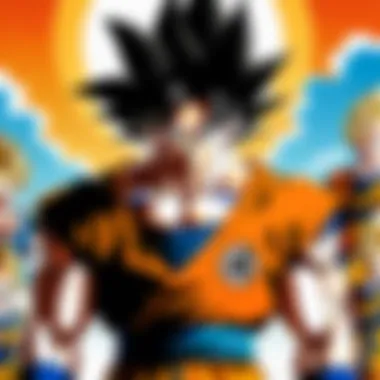The Evolution and Impact of Dragon Ball Comics


Foreword to the Series
Dragon Ball, created by Akira Toriyama, is a groundbreaking manga that began serialization in Weekly Shōnen Jump from 1984 to 1995. It is widely regarded as one of the essential works that popularized the shōnen genre, known for its action-packed storylines and memorable characters. The series was later adapted into a successful anime, enhancing its global appeal.
The premise revolves around Goku, a young boy with extraordinary strength, as he embarks on adventures in search of the Dragon Balls, mystical artifacts that can grant wishes. The blend of martial arts, humor, and adventure hooks readers from the start, capturing the essence of the hero's journey.
On its release, Dragon Ball quickly gained traction, becoming a cultural phenomenon in Japan and later around the world. Its characters, like Vegeta and Piccolo, have become icons in their own right. The rich lore, along with the relatable themes of friendship and perseverance, contribute to its prolonged popularity and critical reception.
In recent years, the legacy of Dragon Ball has continued to thrive, with new series, movies, and merchandise extending its influence in contemporary media. Many anime and manga creators cite Dragon Ball as a significant inspiration, showcasing its impact across various platforms.
"Dragon Ball fundamentally altered the landscape of anime and manga, setting a high standard for storytelling and character development."
This article will explore the various elements that contribute to the ongoing significance of Dragon Ball, including character dynamics, artistic progress, and the broader cultural impact of the series.
Prelude to Dragon Ball Comics
The world of manga and anime is vast, with various series leaving a significant mark in pop culture. Among them, Dragon Ball stands out as a pioneering work that has shaped these industries. This section aims to explore the importance of Dragon Ball comics in this broader landscape. Understanding the Dragon Ball universe is crucial because it encapsulates themes such as friendship, rivalry, and the eternal struggle between good and evil—all of which resonate deeply with readers.
The influence of Dragon Ball extends well beyond its pages. It set a benchmark for action-adventure storytelling in manga, inspiring countless other series. Fans often cite how the linear progression of the storyline keeps them engaged, combining humor with intense battles. Moreover, the character development found within Dragon Ball fosters emotional investment. Readers grow attached to these characters, celebrating their victories and mourning their losses.
This article strives to provide a comprehensive overview of the Dragon Ball comics. It will delve into their origins, creation, core themes, character analysis, artistic style, and cultural impact. Emphasizing these key elements will help illustrate how Dragon Ball not only transformed the manga landscape but also established a cultural phenomenon that endures today.
Origins of the Series
Dragon Ball was first serialized in Weekly Shōnen Jump in 1984. It quickly gained popularity, running until 1995. The series drew inspiration from traditional Chinese literature, particularly the classic novel Journey to the West. This cultural reference adds richness to the story, connecting it with a broader historical narrative.
The series' plot follows the adventures of Goku, a young boy with incredible strength and a penchant for martial arts. His journey begins with the quest to collect the mystical Dragon Balls, which grant wishes when gathered. This core concept remains relatable, as it embodies the universal desire for adventure, discovery, and fulfillment.
Creation by Akira Toriyama
Akira Toriyama, the mind behind Dragon Ball, is an influential figure in the manga world. His unique art style and ability to blend humor with action set him apart from his contemporaries. Toriyama's creative process was characterized by a focus on dynamic characters and engaging plots. Notably, his effort to make characters relatable contributes to the series’ resonance with diverse audiences.
Toriyama's initial work prior to Dragon Ball laid the groundwork for his approach. His distinctive character designs and storytelling techniques evolved throughout the series. This evolution is evident when comparing the early chapters to later volumes, showing a shift in both art style and narrative complexity. Toriyama's ability to adapt and innovate is a key reason Dragon Ball remains relevant in the ever-evolving realm of anime and manga.
"This series some how reflects the human experience, connecting people across generations and cultures through timeless themes."
Core Themes and Narrative Elements
The central themes within Dragon Ball comics serve as a foundation for its storytelling and character development. They resonate deeply with readers, highlighting relatable emotions and moral dilemmas. Understanding these themes will enhance appreciation for the series and clarify its appeal across different cultures and generations.
Friendship and Rivalry
A defining element of Dragon Ball’s narrative is the duality of friendship and rivalry. Characters like Goku and Vegeta exemplify this dynamic. Their relationship evolves over time. Initially, they are adversaries, with Vegeta embodying a fierce rivalry against Goku. However, as the story progresses, they develop a mutual respect and camaraderie. This evolution reflects real-life friendships, where competition can foster growth and improve one’s abilities.
Friendship is portrayed as a source of strength. It drives characters to overcome challenges. Goku's unwavering belief in his friends adds depth to the narrative. Similarly, other characters, such as Krillin and Piccolo, show how bonds can provide motivation in the face of overwhelming odds. This interplay between rivalry and friendship elevates the storyline, encouraging themes of collaboration and understanding amidst competition.


The Concept of Power
The theme of power runs throughout Dragon Ball, addressing both its pursuit and its implications. Power is not merely physical strength; it encompasses emotional and moral dimensions. Characters strive for greater power, often facing moral quandaries along the way. This quest raises questions about the responsibilities that come with strength and the ethical lines that should not be crossed.
Goku symbolizes this quest for power, driven by a desire to protect the ones he loves. Each transformation, from his Super Saiyan form to Ultra Instinct, represents not just an increase in physical capabilities but also personal growth. The depiction of power invites readers to contemplate the effects of ambition and the cost of personal growth.
Good vs. Evil
The theme of good versus evil is another pillar that supports the Dragon Ball narrative. Conflict between protagonists and antagonists is evident in characters like Goku and Frieza. This classic struggle highlights moral complexities. While major villains like Frieza embody evil, even they undergo changes, and their motivations can be intricately woven into the broader narrative.
This theme encourages readers to reflect on the nature of good and evil. The lines are often blurred, with certain characters displaying both benevolent and malevolent traits, thereby enriching their depth. Through this lens, the audience can explore the justification of actions and the multifaceted nature of morality.
"The exploration of themes like friendship, power, and good versus evil not only defines the Dragon Ball universe but also resonates with the human experience."
In summary, the core themes and narrative elements in Dragon Ball comics enhance their overall impact. They provide insight into the characters’ motivations and values. By examining friendship, the pursuit of power, and the struggle between good and evil, readers can connect with the story on a deeper level, appreciating its significant cultural and emotional relevance.
Character Analysis
Character analysis is a fundamental aspect of understanding "Dragon Ball" comics. It goes beyond simply describing characters; it involves examining their growth, motivations, and relationships. This analysis provides insights into the narrative and themes of the series. By delving into character dynamics, readers can appreciate how these figures drive the storyline and embody its core themes. This contributes to the overall impact of the series, revealing the depth behind seemingly straightforward tales.
Goku: The Protagonist’s Journey
Goku is often seen as the quintessential hero. His character represents determination and innocence. From his humble origins as a child in the mountains to becoming the strongest warrior, Goku's journey is one of growth. He starts as naive and curious, and through his experiences, he learns about friendship, sacrifice, and the importance of striving for improvement. His journey drives the narrative, influencing not only his fate but also those around him.
Goku’s unyielding pursuit of strength stems from a genuine desire to protect his friends and family. He constantly seeks new challenges, which keeps the readers engaged. Not only does he embody the ideal of self-improvement, but he also illustrates the effects of positive influences and mentorship throughout the series.
Vegeta: The Evolving Antagonist
Vegeta presents a contrasting character to Goku. Initially introduced as an antagonist, he is driven by pride and a desire for power. However, his character arc transitions from villain to ally, showcasing complexity and depth. Vegeta’s evolution is marked by significant moments of vulnerability and growth, which marks him as one of the most interesting characters in the series.
His rivalry with Goku serves as a catalyst for his development. It ignites a transformation not just in his power but also in his values. Over time, Vegeta becomes a protector of Earth, showing that even the fiercest warriors can change. This duality in his character challenges traditional notions of good versus evil, making his journey compelling and relatable.
Supporting Characters and Their Roles
Supporting characters in "Dragon Ball" are integral to its narrative structure. They serve a variety of functions that help flesh out the world and enrich the main storyline.
- Bulma: Introduced as a friend of Goku, she contributes highly to technological advancements in the series.
- Piccolo: Starting as an enemy, he becomes one of Goku's closest allies, representing growth and understanding between characters.
- Krillin and Gohan: Both characters showcase different aspects of bravery and loyalty, reinforcing the theme of friendship and support.
Each supporting character adds layers to the story. They provide both comic relief and emotional grounding, making the main battle sequences more impactful. Understanding these characters helps readers to appreciate how they influence the dynamics of the series.
The richness of the characters in "Dragon Ball" not only enhances the narrative but also reflects the complexities of human nature.
Through Goku, Vegeta, and the supporting cast, "Dragon Ball" comics reveal the importance of character growth and development. It underscores the notion that character analysis is essential for grasping the subtleties and themes of this iconic series.
Artistic Style and Evolution
The artistic style of Dragon Ball comics is a pivotal aspect of its overall impact and success. From the initial sketches to the highly refined aesthetics seen in later chapters, the evolution of this art form plays a crucial role in engaging audiences. The distinctive artwork aids in character recognition, emotional expression, and the intensity of action sequences. It also sets the tone that resonates with both the story and the themes presented throughout the series.


Initial Art Style
When Dragon Ball first made its debut in 1984, its art style bore the hallmark traits of many contemporary mangas. Akira Toriyama employed a simple yet effective design language. Character designs were often exaggerated, with large eyes and strong physical features, emphasizing strength and humor. The backgrounds, while not overly detailed, were effective in setting the context of each scene. The initial chapters showcased Goku in his early adventures, which were vibrant and simple. This simplicity allowed the story’s comedic elements to shine through, appealing to a younger audience. The choice of colors was also bright, reflecting the playful nature of the narrative.
Evolution Over Time
As the series progressed, the artistic style underwent notable changes. The characters became progressively more detailed, and the action sequences were drawn with a higher emphasis on motion and dramatic flair. The introduction of vehicles, architecture, and more intricate environments reflected a growing complexity in the storyline.
- The evolution showcased:
- More defined character physiques and expressions.
- Enhanced motion lines and dynamic poses during battles.
- Improved backgrounds with more depth and texture.
Through these changes, Toriyama managed to maintain consistency while adapting to the needs of an evolving narrative. As the themes of power and conflict intensified, so too did the illustrations, creating a stronger visual impact. The shift towards more intricate artwork allowed fans to experience the action at a heightened level, becoming fully immersed in the conflicts presented in the story.
Influence on Other Artists
The impact of Dragon Ball's artistic style transcends its pages. Many artists have drawn inspiration from Toriyama's visual language, leading to a new aesthetic paradigm in the realm of manga. The distinctive character designs and dynamic action scenes have become reference points for various creators.
"The influence of Dragon Ball on the manga and anime industry is undeniable, shaping not just styles but also story-telling techniques."
- The legacy of Dragon Ball includes:
- The incorporation of specific visual tropes, such as exaggerated expressions and over-the-top action.
- The popularization of serialized combat-focused narratives among manga artists.
As a result, many series that followed adopted similar stylistic choices, further stretching the boundaries of anime art. The influence can be seen in well-known titles like Naruto and One Piece, as they reflect the aesthetic innovations that began with Dragon Ball. This artistic evolution not only paved the way for future works but also enriched the cultural landscape of anime and manga, cementing its place in history.
Cultural Impact and Reception
The cultural impact and reception of Dragon Ball comics is a vital facet of their legacy. These comics have not only entertained millions but have fundamentally altered the landscape of manga and anime. Over the decades, they have influenced various aspects of pop culture, inspiring new generations of creators and fans alike. Understanding this impact provides insight into why Dragon Ball remains relevant. It invites us to consider the relationship between art and society, especially in the context of a globalized world.
Popularity in Japan
In Japan, Dragon Ball quickly gained a massive following. The series first debuted in 1984 in Weekly Shōnen Jump. Akira Toriyama's art and story resonated with readers. It was fresh, dynamic, and filled with action. Many young readers identified with Goku’s journey, leading to a strong emotional connection. The characters, fight scenes, and humorous moments contributed to rapid sales growth.
The series not only dominated manga sales but also created a vibrant community of fans. Dragon Ball became a cultural phenomenon. It featured prominently in various forms of media, from TV shows to merchandise. This overwhelming popularity led to numerous adaptations and spin-offs, reinforcing its position in Japan's cultural fabric. A combination of compelling narrative and colorful characters ensured that it remained a staple in manga culture.
Global Reach and Influence
Dragon Ball's influence stretches far beyond Japan. The series entered various international markets in the 1990s. It gained immense popularity in North America, Europe, and other regions. Fans engaged with the storylines through translations and dubbed versions.
The series has inspired countless artists and animators worldwide. It set a standard for shōnen manga, blending adventure, comedy, and fantasy in a unique way. Other franchises often cite Dragon Ball as an influence. Many successful anime and manga authors reference it as a source of inspiration.
The global cultural exchange facilitated by Dragon Ball has been substantial. It has fostered an appreciation of anime and manga overseas, leading to a rise in their popularity. This, in turn, has impacted local cultures, generating anime conventions and fandoms that celebrate the source material.
Merchandising and Spin-offs
The merchandising surrounding Dragon Ball is a significant aspect of its cultural impact. The success of the comics led to various products, including action figures, clothing, and collectibles. Bandai's figures and various other branded products have become highly sought after, making them lasting elements in the world of merchandising.


Spin-offs of Dragon Ball have also contributed to its enduring presence. Shows like Dragon Ball Z and Dragon Ball Super continued the saga, introducing new characters and story arcs. Video games based on the series, like Dragon Ball FighterZ and Dragon Ball Xenoverse, have further popularized the franchise. These creations allow fans to engage with the universe in interactive ways, enhancing their experience.
In summary, Dragon Ball's cultural impact is multifaceted. Its popularity in Japan set the foundation for a global influence. Through merchandising and spin-offs, the series has expanded its reach and maintained relevance in contemporary media. Collectively, these factors showcase how Dragon Ball has left an indelible mark on both Japanese and global cultures.
Adaptations and Their Significance
The multiple adaptations of Dragon Ball serve as a testament to its vast influence on the realm of both comics and greater media culture. Understanding these adaptations is pivotal to comprehending the series’ standing today. They bridge the gap between the original comic and various other forms of entertainment, such as anime and video games. Each adaptation plays a critical role in proliferating its themes and characters, not only broadening the story's reach but also enhancing its legacy.
Adaptations make the content accessible to various audiences, often translating the plot and character arcs into formats that resonate differently with viewers or players. This relevance across media showcases the depth and appeal of the narrative and the characters within it.
Moreover, adaptations often lead to expansions of the original story by providing new perspectives or side stories. They give creators a chance to explore different aspects of the Dragon Ball universe, thus keeping the franchise dynamic and fresh.
Anime Adaptation
The anime adaptation of Dragon Ball, produced by Toei Animation, debuted in 1986 after the launch of the manga in 1984. It had a significant impact on how the story was perceived and enjoyed. The vibrant colors and animation brought characters like Goku and Vegeta to life in a manner that the comic could not fully achieve.
This adaptation created a new audience base, particularly among those who prefer animated formats over comics. The anime’s catchy theme songs and dynamic fight scenes contributed to the franchise's popularity. Furthermore, the pacing of the anime allowed for more character development and exploration of subplots, deepening the audience’s attachment to the characters.
The anime also expanded the Dragon Ball lore with additional arcs like Dragon Ball Z, Dragon Ball Super, and others. These additions did not replace the original but instead complemented it, presenting new villains and storylines that captured the imaginations of fans worldwide.
Video Games and Other Media
The video game adaptations of Dragon Ball began with Dragon Ball: Dragon Daihikyou in 1986. Since then, these adaptations have evolved significantly, with many titles offering unique storylines based on the manga and anime. The gameplay mechanics, art styles, and character choices in these games reflect the distinctive qualities of the original series while allowing for player engagement with the Dragon Ball universe.
Popular titles like Dragon Ball FighterZ and Dragon Ball Z: Kakarot immerse players in the world, offering rich narratives and dynamic combat. The games often introduce elements that expand the lore while adhering closely to the canon. In this way, video games not only serve as an entertainment medium but also as a method of storytelling, enhancing the fan experience over generations.
In addition, Dragon Ball extends into other media, including films and merchandise. The continued production of both animated and live-action films showcases the franchise’s adaptability and the ongoing interest in its story. Thus, adaptations remain a key player in the overall impact of Dragon Ball comics, allowing the franchise to maintain its relevance in the evolving landscape of entertainment.
"The various adaptations of Dragon Ball highlight its influence in shaping both anime and video game cultures globally."
In summary, adaptations offer vast significance. They create a pathway for storytelling that resonates with different demographics, ensuring that the heart of Dragon Ball reaches a wide audience. Through these adaptations, the original comics gain a new life, continuing to enthrall fans around the world.
Finale and Lasting Legacy
The legacy of Dragon Ball comics stands as a monumental pillar in the realms of manga and anime. As we conclude our exploration, it is essential to reflect on the multifaceted impact this series has had not only on entertainment but also on culture as a whole. This section aims to synthesize the key components discussed throughout the article while emphasizing their relevance in today's dynamic media landscape.
Reflections on the Saga
Dragon Ball, originating from Akira Toriyama's imagination, has evolved significantly since its inception. Its narrative goes beyond mere entertainment; it encapsulates themes of perseverance, friendship, and self-discovery. Goku's journey from a naive child to a powerful martial artist resonates with many readers, driving a sense of aspiration and determination.
Moreover, the series has been a catalyst for deep cultural analysis. Fans and critics have examined its themes extensively, revealing insights into Japanese society, the nature of heroism, and the morality of strength. The evolution of characters like Vegeta showcases a complex interplay of rivalry and redemption. These narratives have left an indelible mark on generations, shaping the expectations of storytelling within the genre.
"Dragon Ball transcends its origins by becoming a cultural phenomenon, influencing countless works and creators."
As one reflects on the saga, it becomes evident that the series not only entertains but also promotes critical thought. This aspect is central to its lasting appeal, encouraging discussions among fans online and within various communities.
Future Directions
Looking ahead, the future of Dragon Ball comics seems promising but requires careful navigation. The introduction of new content, whether through manga or animated adaptations, invites opportunities for innovation. However, the challenge lies in maintaining the essence that originally captivated audiences.
Future directions may include exploring unexplored character backstories or developing new arcs that resonate with contemporary themes. In this context, the integration of modern technology and storytelling techniques can enhance engagement.
Potential collaborations with new creators might also provide fresh perspectives while respecting the traditional lore and complexity of the original works. As the audience continues to diversify and expectations evolve, the opportunities for growth are substantial.















